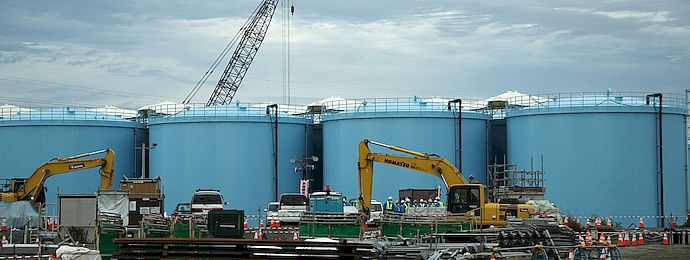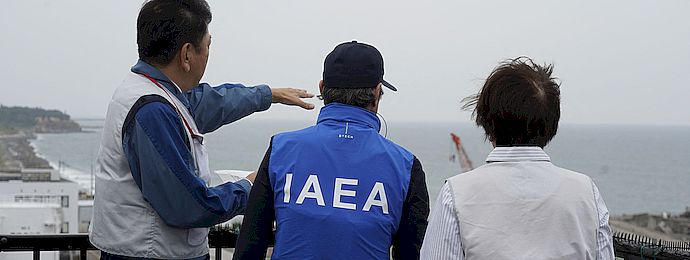-
BASE
subnavigation
BASE
- About us
- Laboratorium
- Career
- Laws and regulations
- Legal Basis
- Manual on Reactor Safety and Radiation Protection
- 1A Nuclear and radiation protection law
- 1B Other laws
- 1C Transport law
- 1D Bilateral agreements
- 1E Multilateral agreements
- 1F EU law
- 2 General administrative provisions
- 3 Announcements of the BMU and the formerly competent BMI
- 4 Relevant provisions and recommendations
- 5 Nuclear Safety Standards Commission (KTA)
- 6 Key committees
- Annex to the NS Handbook
- A 1 English translations of laws and regulations
- Dose coefficients to calculate radiation exposure
- BASE topics in the Bundestag
-
Topics
subnavigation
Topics
Nuclear Safety
Interim Storage / Transport
-
News
subnavigation
Discharge of radioactively contaminated water into the sea off Fukushima
Japanese government wants to dilute contaminated water and feed it into the Pacific Ocean
More than ten years after the accident in Fukushima, it is not only the highly radioactive fuel elements and reactor parts that are stored on site. The water used to cool the damaged plant is also contaminated, and had to be collected in tanks. Now the operator wants to discharge this water into the sea - after chemical treatment and heavy dilution with seawater. The IAEA confirms negligible radiological effects.

![]() Blue tanks with radioactively contaminated water at the Fukushima-Daiichi nuclear power plant
Source: picture alliance / Xinhua News Agency | unreguser
Blue tanks with radioactively contaminated water at the Fukushima-Daiichi nuclear power plant
Source: picture alliance / Xinhua News Agency | unreguser
Following the earthquake and tsunami of 11 March 2011, the building structures and groundwater barriers of the Fukushima Daiichi nuclear power plant (in German) are no longer sufficiently intact, meaning groundwater and rainwater can enter the buildings. Subsequent reactor accidents have destroyed the integrity of the reactor vessels and also the building shell in several power plant units, resulting in serious contamination of infiltrating groundwater and rainwater. This water, which also provides cooling for the damaged plant, is constantly pumped out and collected in tanks on the nuclear power plant site.
About 1.33 million cubic metres of water are currently stored there in over 1000 tanks. Every day, more than 100 cubic metres of water are added in the form of incoming groundwater and rain. The total storage capacity of the tanks is about 1.37 million cubic metres.

![]() Tanks filled with contaminated water at the Fukushima-Daiichi nuclear power plant
Source: picture alliance / ASSOCIATED PRESS | Koji Ito
Tanks filled with contaminated water at the Fukushima-Daiichi nuclear power plant
Source: picture alliance / ASSOCIATED PRESS | Koji Ito
The operator TEPCO points to the capacity limits of the tank facility; in addition, long-term storage poses the risk of leakage and defects in the tanks. Furthermore, the contamination of and thus the radiation from the water in the tanks causes problems relating to radiation protection for the staff on site (compliance with an annual dose of 1 mSv), and ultimately the tanks also constitute an obstacle to dismantling.
Operator pursues discharge of water into the sea
For these reasons, the operator TEPCO is seeking to dispose of this water. Due to the sheer volume, this is to be done by discharging it into the ocean in front of the damaged power plant.
The operator has named the water to be discharged ‘ALPS water’ (Advanced Liquid Processing System) after the preceding purification process. During this treatment, caesium and strontium, which account for the majority of the radioactive contamination, are removed from the contaminated water in a first step. Further radioactive nuclides will subsequently be chemically removed from the water (the operator has listed a total of 62 further radionuclides).
Except for the nuclide tritium (H-3), a β-emitter with a half-life of 12.32 years according to the operator, all radionuclides will be removed in this step to below the applicable limits. According to the current state of the art, it is not technologically and economically possible to remove tritium to the extent required here.
Pipeline leads one kilometre into the sea
TEPCO has stated that it intends to dilute the ALPS water at least 100-fold with seawater before discharging it into the sea, so that the tritium content of < 1500 Bq/l will ultimately fall below the 2.5% mark of the value valid for drinking water in Japan. At the same time, the concentrations of the remaining nuclides would fall below 1% of the limit values.
The discharge is to take place via a one-kilometre-long pipeline, and the discharge quantity is not to exceed 22·1012 Bq tritium (22 TBq/a) per annum.
IAEA verification completed

![]() IAEA Director General Rafael Mariano Grossi visits the Fukushima Daiichi nuclear power plant with his team
Source: picture alliance / abaca | ABACA
IAEA Director General Rafael Mariano Grossi visits the Fukushima Daiichi nuclear power plant with his team
Source: picture alliance / abaca | ABACA
This value also corresponds to the maximum value of the annual release during the operation of the entire Fukushima Daiichi plant, with six reactors totalling 4.7 GW gross capacity. According to TEPCO, the discharge is to extend over a period of about thirty years.
The prerequisites for implementation are the technical inspection and acceptance of the delivery facility by the competent authorities and the safety review by the IAEA Review. The IAEA confirmed at the end of October 2023 that the handling of the treated water meets international safety standards and that the planned release will have negligible radiological effects on humans and the environment. The full IAEA report published at the end of January 2024 - following the discharge of more than 23,000 cubic metres of water - reiterated this conclusion. The IAEA stated that, as the discharge was still in its early stages, inspections were also planned for the future.
Operational discharge vs disposal of waste
During the operation of nuclear power plants, radioactive substances such as tritium or carbon-14 are continuously released into the environment. These operational discharges are subject to the regulations and supervision of the operating countries. German NPPs, too, discharged radioactive substances into the environment via waste water and exhaust air during operation. This is part of the operating licence of the nuclear facilities, and must be continuously monitored.
The contaminated water from Fukushima, however, is not operational discharge, but rather waste from the disposal of consequences of accidents. One basic principle of waste and residual material treatment in Germany, for example, is that waste must not be "diluted". This is to prevent further quantities of material from being unnecessarily contaminated or to prevent the material from being disposed of in a way other than long-term safe landfilling, which could lead to additional pollution of the environment. According to currently applicable standards, a corresponding discharge into the sea would thus not be permissible in Germany.
State of 2024.01.31
